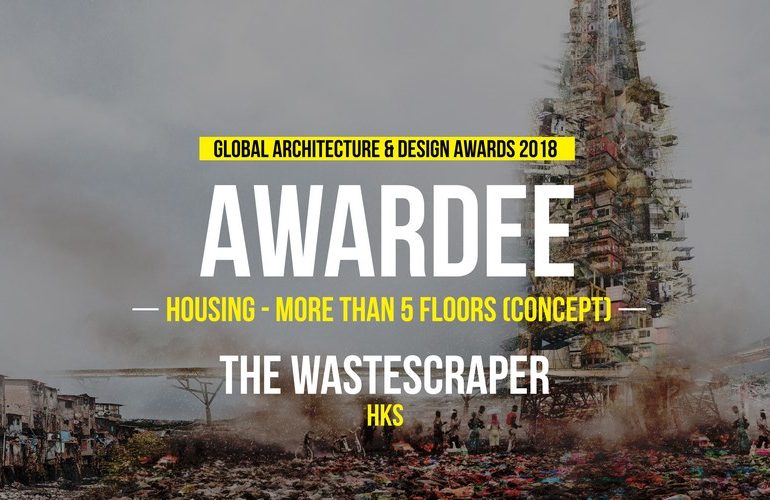E-waste has become a global ecological crisis. Dozens of millions of tons of electronic products are discarded and replaced every year. Over 60 million tons were discarded in 2017, alone.
The Wastescraper acts as a recycling center, marketplace, housing community and filtration plant. It is built as a manifestation of a global thought system that has abandoned ‘hopeless’ geographies of the world, attempting to corner them in the grueling fragility of their conditions.
Global Architecture & Design Awards 2018
Third Award | Category: Housing (More than 5 Floors) (Concept)
Architects: HKS Design Fellowship
Team Members: Dorian Sosa, Francisco Barron, Gordon Gn
Country: United States

Located atop the largest e-waste landfill in the world, “Agbogbloshie Scrapyard” in Accra, Ghana, the tower questions conventional notions of waste and resources, transforming what is considered ‘waste’ into the basis for a new system of architecture – altering and inversing the current one-way flow of resource-to-product-to-waste.
Twenty-two billion dollars of gold were thrown away worldwide in electronics’ waste in 2016.

In Ghana, gold is indicative of the country’s culture. However, there is a duality between gold’s cultural significance and gold’s exploitation for profit. On one hand, gold is used as cultural ornamentation and a symbol of celebration by the people of Ghana. On the other hand, foreign companies irresponsibly mine the Ghanaian geography, throwing slur and pollutants back into the landscape once gold is filtered. This mined gold is then shipped to developed nations for the manufacturing and use of electronic products. These products are soon replaced, making their way back to Ghana through illegal back channels, only this time within a vessel of waste. Gold is then re-mined, resold and re-discarded once again, resulting in a never-ending cycle, detrimental to the environment.

The tower reinterprets this cycle of gold. Gold re-appropriated from extracted e-waste is transformed into an architectural façade material, allowing the residents of Accra to take ownership of the resource that was once native and culturally inherent to them. The façade re-captures Ghanaian symbols, figural elements keen to their culture, that operate both spatially to the interior and as a veil to the exterior.
Usable energy can be generated from waste.

Agbogbloshie Scrapyard is layered with copious amounts of methane and carbon dioxide gases, generated from the tremendous volume of electronic and organic waste found on site. The Wastescraper harnesses such gases through energy recovery processes to produce biofuels and other forms of energy used for electricity, heat, air filtration, cooking, and farming within the building. In addition, the tower applies passive energy systems like natural ventilation, convection and evaporation for the natural cooling and air flow movement throughout the structure. At the ground plane, natural methods such as bioremediation heal the land over time using microorganisms to remove toxins from the soil. The project is a model for the responsible use and re-use of energy. It creates a closed cycle between waste and resource.
A new monument in Agbogbloshie.

Out of a landscape that once lay waste, emerges a new architectural icon that regenerates and re-engages the ground. It acts as a monument to the technological tragedy of the commons, challenging society’s rate and need for digital and physical consumption.
If you’ve missed participating in this award, don’t worry. RTF’s next series of Awards for Excellence in Architecture & Design – is open for Registration.
Click Here








